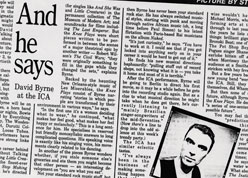ORIGINAL
PRESS CLIPPINGS

A ROBERT WILSON PROMER:
THE ENIGMATIC AUTHOR AND HIS "KNEE PLAYS"
It is the same with "the CIVIL warS," of which "the Knee Plays" forms a significant part. Wilson has said that his theme in "the CIVIL warS" is not America's War Between the States — though this is a pervasive reference point, and a giant figure of Lincoln figures prominently in the Cologne section — but civil conflict in its broadest generality. Within this context, as Wilson himself explains in a program note, " 'the Knee Plays' is like a sub-story that is woven throughout the tapestry of 'the CIVIL warS.' Each play serves as an introduction to the longer scene that follows ... the tree in the first knee play is meant to be a tree of life, perhaps in Africa, thought to be the origin of man."
Wilson goes on to identify the key images of "the Knee Plays" and how they link with each other and the recurrent allusions of the opus, including such things as Adm. Perry and his voyages to Japan, and the undersea musings of Jules Verne. Along with the tree, the main "objects" that carry the symbolic currents of the work along are a book and a boat. And if "the Knee Plays" begins with the tree of life, in a sense it ends with the tree of knowledge, in the final imagery of a book growing out of a tree.
The tour of "the Knee Plays" is but the tip of the Wilsonian iceberg, so to speak. On the Wilson agenda for the foreseeable future are, among other things, a Gluck "Alceste" in Stuttgart with Jessye Norman ; a "King Lear" in Hamburg; a "Salome" for Milan's La Scala; T.S. Eliot's "Waste Land" in Cambridge; a film collaboration with David Byrne about the Industrial Revolution; and a new, five-hour opera in collaboration with Philip Glass. If you want to take your first Wilson plunge, though, "the Knee Plays" is not only at hand, but very likely an ideal place to start.